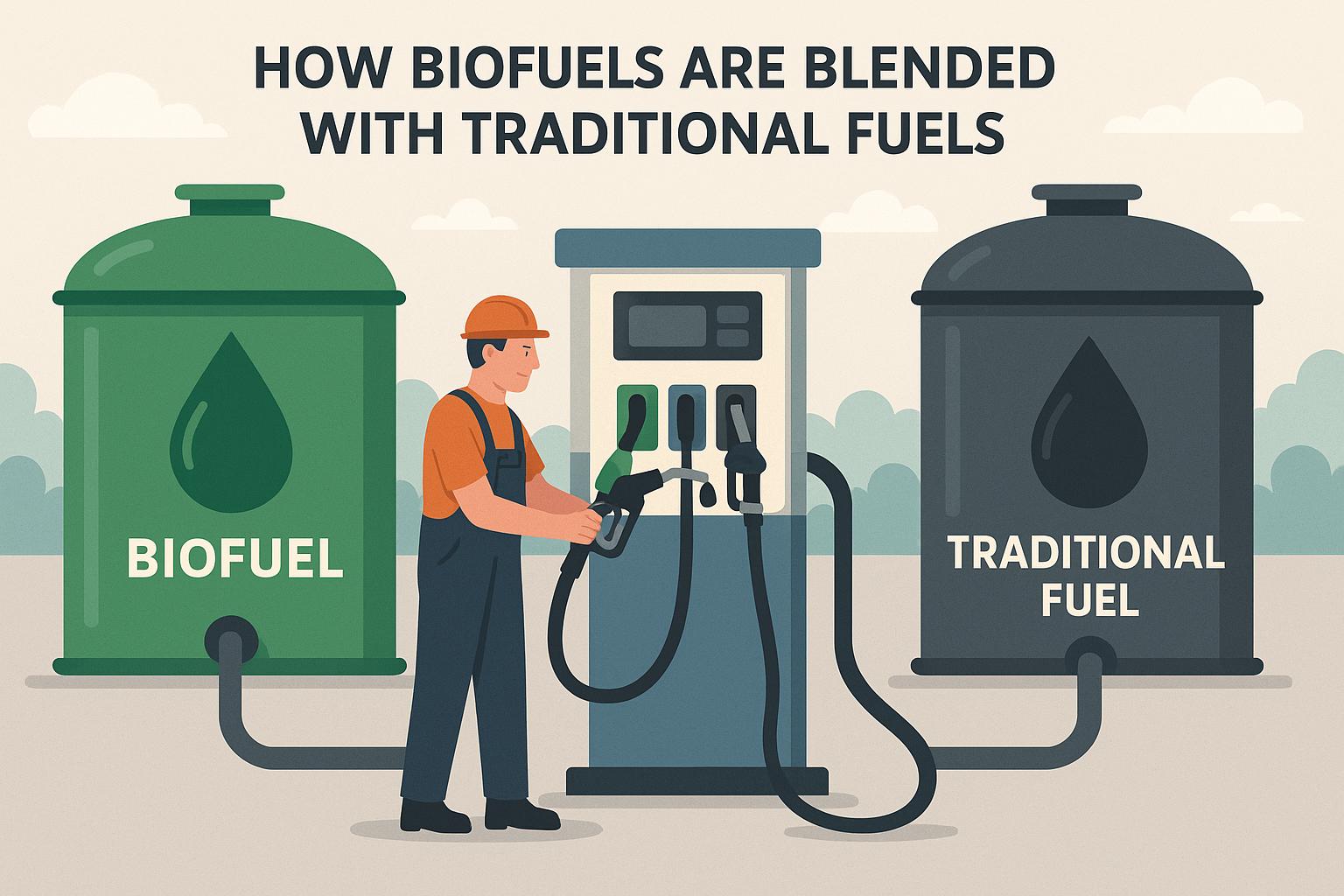Introduction to Biofuel Blending
The integration of biofuels with traditional fossil fuels represents a significant advancement in the quest for more sustainable energy sources. Biofuels, derived from biological materials such as plants and organic waste, can be blended with petroleum-based fuels to reduce greenhouse gas emissions, enhance energy security, and stimulate rural economies. This blending process is critical as it transitions the energy sector towards more renewable practices.
Understanding Biofuel Composition
Biofuels encompass a variety of organic fuel sources, the most common being ethanol and biodiesel. Ethanol is primarily produced from crops like corn, sugarcane, and grain. It serves as an alcohol that can be mixed with gasoline to produce fuel suitable for combustion engines. On the other hand, biodiesel is usually derived from vegetable oils, animal fats, or recycled cooking oil. This type of fuel can blend with diesel to power vehicles that rely on diesel engines, offering a renewable alternative to fossil diesel. These fuels can be blended with gasoline and diesel in varying proportions to create different fuel grades, catering to different energy requirements and emissions standards.
Blending Ratios and Industry Standards
Ethanol and biodiesel are typically blended in specific ratios with traditional fuels. For ethanol, the most common blend is E10—a mixture of 10% ethanol and 90% gasoline. However, higher ethanol blends such as E15, E85, and even up to E100 are available for vehicles designed to utilize higher ethanol content. E15, for example, offers a 15% ethanol blend, resulting in slightly lower emissions and is suitable for newer vehicles. E85, offering an 85% ethanol content, is intended for flexible-fuel vehicles that can adjust to different ethanol levels. E100, practically pure ethanol, is mainly used in specialized engines.
Similarly, biodiesel blends like B5 (5% biodiesel, 95% diesel) and B20 are widely used, with B100 options available for specifically adapted engines. The B5 blend is suitable for all diesel engines and does not require any modifications, whereas B20 can be used in most engines with minor adjustments. These standards are generally set by regulatory bodies and vary by region. More information on specific ratios and regulations can be found through industry organizations like the Alternative Fuels Data Center.
Technical Factors in the Blending Process
Blending biofuels with traditional fuels involves several technical considerations to ensure compatibility and performance. These include aspects like octane rating for gasoline blends, which relates to the fuel’s ability to resist engine knocking. Octane rating is crucial for performance optimization, ensuring engines run smoothly with reduced wear and tear. For diesel blends, the cetane rating is significant, which reflects the combustibility of the fuel in compression engines. A higher cetane number ensures better ignition quality and improved emissions performance in diesel engines.
Additionally, the overall energy density of the blended fuel impacts the fuel efficiency. Ethanol and biodiesel have different energy values compared to gasoline and diesel, influencing the amount of fuel required for travel over specific distances. It’s important to optimize these properties to maintain fuel efficiency and engine performance, requiring detailed scientific understanding and adaptation by engine manufacturers.
Storage and Distribution: Blended fuels require appropriate storage solutions to prevent phase separation, especially in varying temperatures. Ethanol, being hygroscopic, tends to absorb water, which can separate the fuel into layers, causing problems like corrosion in engines and storage systems. Therefore, specialized storage tanks and environmental controls are necessary. Similarly, biodiesel’s cold-flow properties necessitate specific conditions to avoid solidifying at low temperatures.
Furthermore, transportation and handling procedures must adhere to guidelines to maintain fuel integrity. Modern infrastructure, such as pipelines and gas station tanks, need to accommodate these new mixtures without compromising their quality, which represents a logistical challenge for the energy industry.
Environmental and Economic Impacts
The use of biofuel blends significantly reduces carbon emissions compared to pure fossil fuels by utilizing CO₂ absorbed by plants during growth. This cycle, known as the carbon cycle, creates a potential for a more sustainable carbon footprint. By drawing down carbon during the growth phase and emitting it during combustion, biofuels tend to offer a closed-loop solution to carbon emissions. Moreover, biofuels contribute to a cleaner environment by reducing harmful pollutants, such as particulate matter and sulfur oxides, associated with traditional fossil fuels.
Economically, biofuels can stimulate the agricultural sector by creating demand for biofuel crops, thus providing farmers with additional revenue streams. This demand not only supports farmers but also enhances the entire rural economy, encouraging investments in agriculture and providing jobs in farming communities. By shifting energy dependencies towards biofuel production, countries can also reduce their reliance on imported fossil fuels, offering greater control over energy resources and boosting energy security.
Challenges and Future Directions
Despite the advantages, biofuel blending faces certain challenges. These include land use concerns, where the increase in crop production for biofuels may lead to deforestation or alteration of natural landscapes, potentially affecting biodiversity. Furthermore, the food versus fuel debate raises ethical concerns about diverting agricultural resources from food production to energy production, which could affect food prices and accessibility, especially in developing regions.
The technological advancements needed to improve production efficiencies remain crucial for the future of biofuel expansion. Currently, first-generation biofuels, derived from food crops, dominate the market, but research is focusing on second and third-generation biofuels that utilize non-food biomass and algae. These advancements aim to improve yield and reduce the environmental footprint without compromising food sources.
Continued research and development are essential for overcoming these hurdles. Innovations in feedstock diversification and advanced processing technologies, such as enzymatic hydrolysis and gasification, will play a critical role in enhancing biofuel viability. These technologies can convert a broader range of organic materials into biofuels, increasing the efficiency and scope of biofuel production. Government policies and subsidies will also play a crucial part in encouraging the growth and adoption of biofuels, providing a stable framework for industrial growth and consumer acceptance.
Integrating biofuels with traditional energy supplies is a complex, yet promising, approach to achieving more sustainable energy strategies in the future. As technological, environmental, and economic factors are addressed, biofuels have the potential to significantly contribute to the global energy landscape. The transition to biofuel blends is not only crucial for reducing the environmental impact of energy consumption but also for establishing a more resilient and diversified energy economy. In doing so, it paves the way for a future oriented towards sustainability and energy independence.


